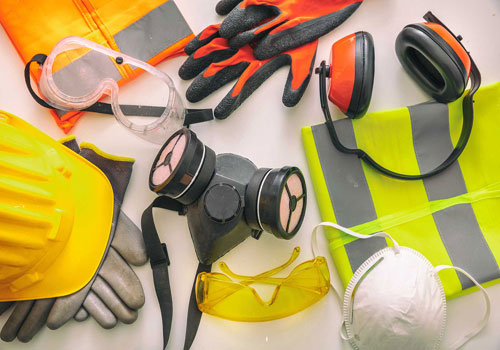
Personal Protective Equipment (PPE) is essential in various industries and settings to protect individuals from potential hazards, injuries, or exposure to harmful substances. The type of PPE required depends on the specific job tasks and the associated risks. Here’s a list of common types of Personal Protective Equipment:
Personal Protective Equipment: Head Protection
Head protection is a critical component of Personal Protective Equipment (PPE), designed to safeguard individuals from head injuries and potential hazards in the workplace. Here are key elements of head protection:
Hard Hats: Hard hats are commonly used in construction, industrial, and other settings where there is a risk of falling objects or head bumps.
Bump Caps: Bump caps are lighter and provide less impact protection than hard hats.
Safety Helmets: Safety helmets, similar to hard hats, provide protection against impact and penetration.
Face Shields Face shields, when attached to a hard hat or safety helmet, protect the face from flying debris, chemical splashes, and other hazards.
Visors: Visors are transparent shields that protect the face and eyes.
Chinstraps: Chinstraps help secure the hard hat or safety helmet on the wearer’s head, preventing it from falling off during movement or in the event of an impact.
Sun Shields and Brims: Sun shields and brims are Personal Protective Equipment attachments that provide protection from the sun, reducing glare and shielding the face and neck from sunlight.
Reflective Strips: Reflective strips on hard hats enhance visibility, especially in low-light conditions or areas with moving vehicles.
Personal Protective Equipment: Eye Protection
Eye protection is a crucial component of Personal Protective Equipment (PPE) designed to prevent injuries and safeguard the eyes from various workplace hazards. Here are key elements of eye protection:
Safety Glasses: Safety glasses are a common form of eye protection and are suitable for general tasks.
Safety Goggles: Goggles provide a more secure and enclosed eye protection, forming a seal around the eyes to prevent particles, liquids, or chemicals from entering.
Face Shields: Face shields are Personal Protective Equipment cover the entire face, including the eyes, and provide protection against flying debris, chemical splashes, and other hazards.
Welding Helmets: Welding helmets have a protective lens to shield the eyes from intense light and radiation produced during welding processes.
Safety Goggles with Face Shields: Some goggles come with integrated face shields, offering comprehensive protection for the eyes and face in one piece of equipment.
Hearing Protection
Hearing protection is Personal Protective Equipment (PPE) vital in environments where there is exposure to loud noises that could potentially cause hearing damage or impairment. Here are key elements of hearing protection:
Earplugs: Disposable or reusable plugs that are inserted into the ear canal to block or reduce the entry of sound.
Earmuffs: Protective ear coverings with sound-absorbing cups that completely enclose the ears.
Electronic Hearing Protection: Advanced earmuffs with electronic components Personal Protective Equipment that allow wearers to hear low-level sounds while providing protection against sudden loud noises.
Custom Molded Earplugs: Earplugs customized to the individual’s ear shape and size.
Communication Earmuffs: Earmuffs equipped with communication features, such as built-in microphones and speakers, to allow wearers to communicate while still protecting their hearing.
Respiratory Protection
Respiratory protection is a critical category of Personal Protective Equipment (PPE) designed to safeguard individuals from inhaling harmful airborne contaminants. Here are key elements of respiratory protection:
Here are key elements of respiratory protection:
N95 Respirators: Designed to filter out at least 95% of airborne particles. Commonly used in healthcare and various industries.
Half-Mask Respirators: Covering the nose and mouth, these respirators use replaceable filters or cartridges to protect against specific contaminants.
Full-Face Respirators: Covering the entire face, they provide eye protection in addition to respiratory protection.
Disposable Masks: Disposable masks, such as surgical masks or procedure masks, are Personal Protective Equipment loose-fitting and primarily designed to protect others from respiratory droplets expelled by the wearer.
Powered Air-Purifying Respirators (PAPRs): PAPRs use a motorized fan to draw air through filters or cartridges, providing a continuous flow of clean air to the wearer.
Hand Protection
Hand protection is a crucial aspect of Personal Protective Equipment (PPE) designed to safeguard the hands from various hazards in the workplace. Here are key elements of hand protection:
Disposable Gloves: Made of latex, nitrile, or vinyl, disposable gloves protect against contaminants and are commonly used in medical, laboratory, and food handling settings.
Chemical-Resistant Gloves: Designed to provide protection against chemicals, acids, solvents, and other hazardous substances.
Cut-Resistant Gloves: Constructed with materials like Kevlar or stainless steel to protect against cuts, abrasions, and punctures.
Heat-Resistant Gloves: Suitable for tasks involving high temperatures, such as welding or handling hot objects.
Cold-Weather Gloves: Insulated gloves for protection against cold temperatures and wind.
Impact-Resistant Gloves: Featuring additional padding or reinforcement to protect against impacts, crushing, or vibrations.
Foot Protection
Foot protection is an essential component of Personal Protective Equipment (PPE) designed to safeguard the feet from various workplace hazards. Here are key elements of foot protection:
Safety Shoes:
Safety shoes, also known as steel-toe boots or safety boots, have reinforced toes (steel, composite, or aluminum) to protect against impact and compression.
Safety Boots:
Similar to safety shoes but with additional ankle support, safety boots provide protection against rolling or twisting of the ankle. Metatarsal Guards:
Attachable guards that cover the metatarsal bones on the top of the foot, providing additional protection against impact and compression.
Electrical Hazard (EH) Boots:
EH boots are designed to protect against electrical shocks and hazards.
Body Protection
Body protection is a crucial aspect of Personal Protective Equipment (PPE) designed to shield individuals from various workplace hazards that may affect the torso and other parts of the body. Here are key elements of body protection:
Coveralls: Full-body coveralls provide comprehensive protection against contaminants, chemicals, or other hazardous materials.
Aprons: Aprons protect the front of the body from splashes, spills, or other workplace hazards. They are available in various materials, including PVC, rubber, and cloth.
Chemical-Resistant Suits: Specially designed suits that provide protection against exposure to chemicals, acids, and corrosive substances.
High-Visibility Clothing
High-visibility clothing, often referred to as Personal Protective Equipment (PPE), is designed to enhance the visibility of individuals in various work environments. Key elements of high-visibility clothing include:
High-Visibility Colors: Hi-vis clothing is typically made in bright colors, with fluorescent shades like neon yellow, orange, or lime green being the most common.
Reflective Materials: Reflective strips or bands are strategically placed on hi-vis clothing.
Visibility Standards: Hi-vis clothing often complies with industry standards and regulations, such as those set by organizations like the American National Standards Institute (ANSI) or the International Safety Equipment Association (ISEA).
Garment Styles: Hi-vis clothing is available in various styles to suit different work environments and tasks. Common styles include vests, jackets, shirts, pants, coveralls, and rainwear.
Enhanced Visibility Features: Some hi-vis garments come with additional features for enhanced visibility, such as color-blocked designs, contrasting materials, or reflective piping.
Fall Protection Equipment
Fall protection equipment is a critical component of Personal Protective Equipment (PPE) designed to prevent or mitigate injuries resulting from falls in the workplace. Here are key elements of fall protection equipment:
Retractable Lifelines: Retractable lifelines are devices that automatically extend and retract, allowing workers to move freely while maintaining a constant connection to an anchor point.
Proper training on the correct use, Personal Protective Equipment maintenance, is essential to ensure its effectiveness in safeguarding individuals from workplace hazards.
CLC company is concerned with the maintenance of personal protective equipment and partners with EGYPES company.
More details about this project will be discussed at the event


